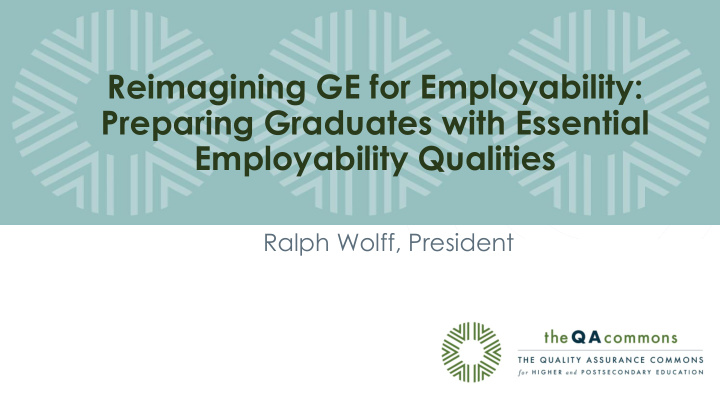



Reimagining GE for Employability: Preparing Graduates with Essential Employability Qualities Ralph Wolff, President
The Quality Assurance Commons for Higher & Postsecondary Education MISSION: To develop a new approach for quality assurance that responds to the changing landscape of higher and postsecondary education and will serve the needs of learners, employers, and the larger society. Funded by the Lumina Foundation 2
Gaps Between Higher Education & Employers 98% of Chief Academic Only 11% of business Officers rate their leaders strongly agree institutions as very or that graduating students somewhat effective at have the skills and preparing students for competencies they need. the world of work, BUT … Source: 2015 Gallup-Purdue Index 3
Students’ Perspectives Only 25% of students are in a major with Only 40% of seniors feel established career paths their college experience at their institutions has been very helpful in preparing for a career. AND … Source: McGraw Hill’s 2016 Workforce Readiness Survey 4
Students Want Jobs! Since 2010, 86% of incoming freshman have said that getting a job represents a critical factor in their decision to enroll in college. Only 17% of those using career service offices found them helpful. (Gallup-Purdue Index, 2016) 5
3 DIMENSIONS OF THE GAP 1. Skills Gap 2. Documentation of Students’ Abilities 3. Identification of /Alignment with Employer Needs 6
Graduates of the EEQ Certified Program are: • Communicators • Thinkers & Problem Solvers • Inquirers • Collaborators • Adaptable • Principled & Ethical • Responsible & Professional • Continuous Learners 7
The EEQ CERT PILOT In 2017-18, we partnered with 27 programs from 14 colleges and universities serving 35,000 students to co-design a certification for educational programs leading to the EEQ CERT.
PILOT LESSONS LEARNED – FIVE CRITERIA 1. Graduate Preparation -- Lack of clear graduate proficiencies -- Not job related -- Not well assessed 2. Career Support Services -- Too little too, too late -- Disconnected from other services/academic programs -- Little support for humanities and social science majors 9
LESSONS LEARNED – FIVE CRITERIA 3. Employer Engagement -- Too often promotional -- Little connection to taught curriculum/assignments -- Increasingly frustrated, seeking other approaches 4. Student and Alumni Engagement -- Little beyond course evaluation -- Lack of adaptation to adult students -- No attention to alumni 10
LESSONS LEARNED – FIVE CRITERIA 5. Public Information -- Typically lists courses not career pathways -- Little connection to employers -- Lack of completion or salary and other information 11
NEW INITIATIVES – Fall 2018 Launch Statewide Prototype with the Kentucky Council on Postsecondary Education: • 19 programs at 6 institutions (3 community colleges/3 Universities • Stakeholder Advisory Committee of Employers, Provosts, Students • Faculty Fellows Program on Defining and Addressing Workforce Needs 12
How Can General Education Meet Employer Needs for Essential Employability Qualities? 13
PROMISING PRACTICES Guttman College – Ethnography of Work Warren Wilson College: Internship Evaluation Aligned with EEQs Central Oklahoma University: Student Transformative Learning Record (STLR) Texas Lutheran University: Applied Physics Career Options Ed Design Lab: 21 st Century Competency Badges 14
What About a GE Consortium Focused on Demonstrating EEQs Aligned with Employer Needs and the Major? 15
Thank You Contact: ralph@theqacommons.org
Recommend
More recommend